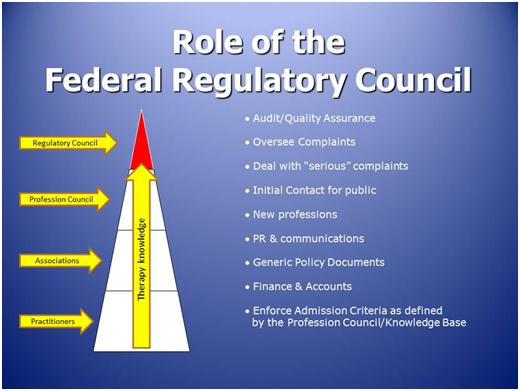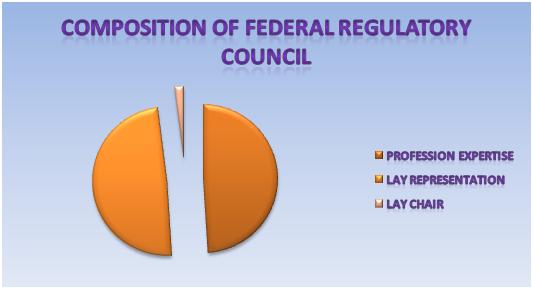Page Contents
The Federal Regulatory Council (FRC)
Like any valid regulatory body GRCCT has a direct input from the professions it regulates. Direct input ensures that each profession is fully involved in all regulatory decisions and how any decision impacts on the practice of every therapy.

The Federal Regulatory Council (FRC) is central to the operation of GRCCT and makes all regulatory decisions. In the same manner as the statutory Health Professions Council (HPC), the FRC is composed of a practitioner from each of the regulated professions and an equal number of lay members. The Council is chaired by a Lay Chair rendering it majority lay.

It the past complementary therapies have sometimes been seen to be dominated by individuals or organisations rotating through a series of positions within umbrella or self-regulatory structures. This has become known as the ‘tic syndrome’. For each meeting of the FRC the Profession Council or Knowledge Base for each regulated profession is required to nominate an appropriate attendee. The facility for each profession to choose the same or a different individual to attend each meeting ensures best practice as no single body or individual can exert disproportionate influence on the regulatory process. The ‘tic syndrome’ is obviated.
The work of the FRC and all subsequent boards is overseen by a lay Board of Trustees. The five trustees are individuals of good standing with no connection to complementary medicine. The Board of Trustees ensures that the activities of the Council are conducted in accordance with due process. The Board of Trustees has no power to rescind or modify the decision of the FRC but may instruct an item to be revisited if a decision has been taken without due process. The Board of Trustees ensure that the annual accounts are duly audited and presented.
The day to day operation of the GRCCT is conducted by an administration team of four. There are also five contract employees who have been trained and security checked to work on GRCCT systems. These contract employees are used as required to cover sickness and holidays. This facility also ensures that admissions to the National Register are processed in good time on occasions such as when a new profession is granted admission and large numbers of applications are received in a short time period.
Financial Structure
The GRCCT is applying to become a Community Interest Company (CIC). Community Interest Companies (CICS) are limited companies, with special additional features, created for the use of people who want to conduct a business or other activity for community benefit, and not purely for private advantage. This is achieved by a “community interest test” and “asset lock”, which ensures that the CIC is established for community purposes and the assets and profits, are dedicated to these purposes. Registration of a company as a CIC has to be approved by the Regulator who also has a continuing monitoring and enforcement role
View the GRCCT draft Memorandum and Articles of Association
Why become a Community Interest Company?
Compared with an ordinary company the CIC has:
- an asset lock, which is inexpensive and easy to set up
- statutory provisions that prevent the members of the CIC removing the asset lock by special resolution
- regulation to ensure the CIC maintains its asset lock and provides benefit to the community it was set up to serve
- checks and balances provided by CIC legislation
- a community benefit report open to public scrutiny
- transparency of directors’ remuneration and use of assets
- legal protection from demutualisation and windfall profits being paid to directors and members.
